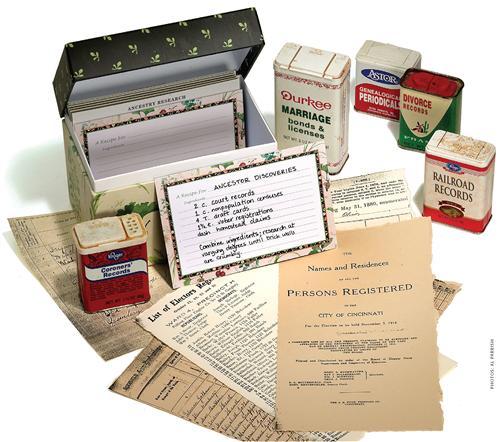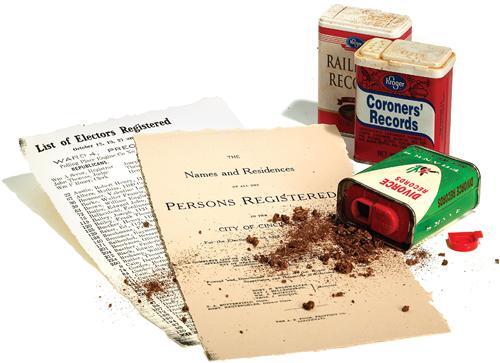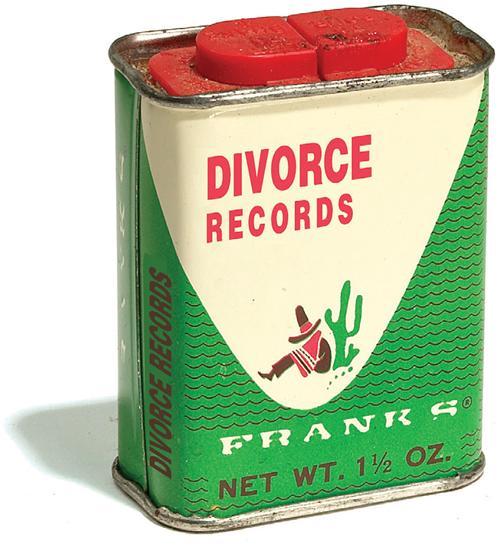Sign up for the Family Tree Newsletter Plus, you’ll receive our 10 Essential Genealogy Research Forms PDF as a special thank you!
Get Your Free Genealogy Forms
"*" indicates required fields
Genealogy is like a kitchen spice rack. You may have 10 to 15 different spices in your cupboard, but you use only a few in almost every recipe: salt, pepper and maybe garlic powder. Every now and then, a recipe calls for other spices—rosemary, curry, thyme, sage—that have been in your cabinet for heaven knows how long, but they’re there when you need them. Similarly, in genealogy, you may rely on those few records that researchers use all the time in their ancestral quests: censuses, vital records, wills and deeds. But in order to break through the brick walls in your family research, you’ll need to look at the lesser-used records in your genealogical repertoire. We’ve identified 10 such sources that are sure to spice up your search.
1. Draft records
Most genealogists think to look up military records, but they often overlook draft records, which can hold a wealth of clues about your kin. Although you may find draft records for other wars, these are the two most widely available record groups.
• Civil War: In 1863, the federal government established a draft system to boost the Union’s war effort. This draft, which affected physically fit white citizens as well as noncitizens who had declared their intention to naturalize, superseded any state and territorial draft systems. The records are part of National Archives and Records Administration (NARA) <archives.gov> Record Group 110, available only at NARA’s research center in Washington, DC.
The principal records are in bound volumes, arranged by state, then enrollment or congressional district, then by class. Class I comprised men between the ages of 20 and 35, and unmarried men between 35 and 45; Class II comprised married men between 35 and 45; and Class III comprised veterans or those currently in service. Entries in the volumes show each man’s name; place of residence; age on July 1, 1863; occupation; marital status; state, territory or country of birth; and, if Class III, the military organization. Unfortunately, these records haven’t been microfilmed, so you’ll need to view them at the National Archives or hire someone there to check them for you.
• World War I: The government held three draft registrations for World War I: one in 1917 and two in 1918. More than 24 million men between the ages of 18 and 45 registered, although not all were inducted into service. Registration cards may include the registrant’s name, age, date and place of birth, home address, race, citizenship, occupation, personal description and prior military service. This information can lead you to domestic or foreign military service records.
WWI draft records are arranged alphabetically by state, then by county or city (except for the cards for Connecticut, Massachusetts and Rhode Island, which are arranged alphabetically by registrant). To get the registration record for a man who lived in a rural area, you need to know only his name and the county where he registered. For a man who lived in a major city, you must know the registrant’s street address because larger cities had several draft boards. To locate someone’s address, consult old city directories (for details, read the August 2003 Family Tree Magazine).
The original WWI draft records are located at the National Archives Southeast Region facility in East Point, Ga. They’re also available on microfilm through the Church of Jesus Christ of Latter-day Saints’ Family History Library (FHL) <www.familysearch.org> in Salt Lake City and its branch Family History Centers (FHCs). Visit <www.familysearch.org/eng/library/ fhc/frameset_fhc.asp> to find the FHC nearest you. You can search the FHL’s holdings online by clicking on the Search tab and then Family History Library Catalog. Once you’ve found microfilm that interests you, request it through the library or your local FHC. (For more on the FHL, read the November 2003 Trace Your Family History, a special issue of Family Tree Magazine.)
One last place to look for WWI draft records is online. Ancestry.com <www. ancestry.com> offers its WWI Draft Registration Cards database as part of its US Records Collection subscription. This database currently covers most states, and it features digital copies of the cards. Roots Web hosts a free database covering about 15 percent of US counties at <userdb. rootsweb.com/ ww1/ draft/ search.cgi>. You’ll find links to transcribed registration-card data at <members.aol.com/ rayhbanks/ cos.html>. The free sites don’t include card images, but could confirm that a record exists and provide clues.
2. Homestead records
In 1862, President Lincoln signed the Homestead Act, which offered 160 acres of free land to adults who agreed to settle and cultivate the land for at least five years. The act applied to US citizens and aliens who had filed for citizenship.
If your ancestor lived out West during the mid-19th century, there’s a good chance he acquired his land under the Homestead Act. But keep in mind that even though interviews, letters and diaries may reference a family “homestead,” that doesn’t mean your ancestor acquired his land that way. Referring to any property as a homestead was common at that time.
Also remember that many homestead claims were canceled because the applicant didn’t meet the requirements. Of the 2 million homestead applications, more than half fell through. For instance, at the end of the five-year term, a non-naturalized immigrant had to have been granted citizenship to secure his homestead. If your ancestor’s application was canceled, there should be a file explaining the cancellation.
Homestead files are kept at the National Archives. You also should be able to find the homestead recorded in the county courthouse where the land is located, or at the state’s Bureau of Land Management (BLM) office. The county record should tell you the federal land office where your ancestor made the claim, the file number and the legal land description. With this information, you can write to the National Archives or the appropriate BLM office for a copy of the complete homestead file.
3. Supplemental censuses
You’ve surely used federal census records in your research, but have you ever examined a nonpopulation census? Over the years, Congress has asked census takers to supplement general population data with information about farming and manufacturing across the country. These supplemental schedules can add valuable details to your family’s story.
• Manufacturing / industry schedules:
These schedules don’t provide vital statistics and family relationships, but they will give you an idea of the types of businesses that existed in your ancestor’s community. Manufacturing/industry schedules typically asked for the name of a company or individual, the name and value of the product made, the quantity and value of raw materials used, the type of machinery used, and the number of employees and their wages.
Whether your ancestor was an entrepreneur or an employee, the schedules can fill in details about his work life. They also can give you a sense of the businesses he patronized. With these businesses’ names, you may be able to track down old account books that list your ancestor’s purchases.
The first manufacturing schedule was taken in 1810, although most of that data has been lost. You can, however, find data for a few counties in the population census, published on NARA microfilm M252, which you can get at many repositories, as well as online. The 1820 manufacturing schedules aren’t complete, either, but you’ll find returns for some individuals on NARA microfilm M279. The FHL has these schedules on microfilm, as well.
The 1850 through 1880 schedules (called “industry schedules” between 1850 and 1870) are microfilmed by state. To find the appropriate microfilm, search NARA’s online microfilm catalog (log on to <archives.gov/ research/ tools>, scroll down and click on Microfilm Catalog). You also might check with the state archives, library and historical society, as they usually hold the most complete collection of the state’s supplemental schedules. The government did take subsequent manufacturing / industry censuses, but those schedules were destroyed by congressional order, probably to save space.
• Agriculture schedules: These schedules give you a glimpse of your ancestor’s farm life, right down to the numbers and kinds of produce and livestock he owned. The enumerations are especially important when you have to differentiate between two men of the same name in one community — after all, no two people had the same acreage and livestock.
Schedules list the name of the owner, agent or tenant and the kind and value of acreage, machinery, livestock and produce. Though enumerations were taken from 1840 to 1910, only the 1840 through 1880 schedules are available for research. The 1890 schedule went up in smoke with the 1890 population census, and the 1900 and 1910 schedules were destroyed by a congressional order. NARA has microfilmed schedules for some states; the rest of the schedules are held at different repositories around the country. As with manufacturing schedules, you should check with your ancestral state archives, state library and historical society.
4. Voter records
Voter registrations can include a name, address, telephone number, party affiliation, date of birth and Social Security number. Some records even provide naturalization information, so they’re particularly helpful to anyone researching immigrant ancestors.
Before 1906, when the Bureau of Immigration and Naturalization was established, each state had its own residency requirements for aliens and their eligibility to vote. After 1906, citizenship was required before an immigrant could vote.
Generally, voter records are kept at the county or city level, although some states keep voter lists in the secretary of state’s office. You’ll find that some counties keep voter-registration records for only the past five to seven years; others may have retained older records. Or they may have donated registration lists to a local library or archive. Check the FHL catalog for microfilmed voter records.
5. Court records
If you haven’t ventured into court records, it’s time to make a trip to your ancestral county courthouse. There, you can find all kinds of fabulous documents detailing marriages (see number 7) and divorces (see number 8), wills, adoptions, civil and criminal proceedings, deeds and mortgages, naturalizations, military discharges and more. If you can’t make it to your ancestor’s county courthouse, search the FHL catalog (perform a place search) for microfilmed court records. (To learn more about accessing court records from afar, read the June 2003 Family Tree Magazine.)
6. Coroners’ records
If you learn or suspect that an ancestor died from uncertain or unusual circumstances—an accident (such as drowning, burns, drug overdose, mine explosion), alcoholism, suicide, murder or criminal negligence—look for a coroner’s record. Children especially were prone to accidental deaths in previous centuries. If a child in your family history died young, but you don’t know the cause of death, check to see if there’s a coroner’s report. These records often predate vital registration and might be the only documents you’ll find on that person.
If the coroner determined the cause of death was criminal negligence or murder, he held an inquest. The inquest papers will hold some meaty details. During an inquest, the court appointed jurors and called witnesses to testify. Some of these witnesses may have been relatives, and in addition to their names and relationships to the deceased, the records might include their addresses. If medical facts intrigue you, the postmortem findings (autopsies) will be especially fascinating. In coroners’ records, you also may find an inventory of personal effects that were found on the deceased person’s body.
Coroner and medical examiner files generally are open to the public. If the ones you need aren’t, though, family history research is usually a legitimate reason to gain access to them. Some pre-20th-century coroners’ reports have been microfilmed, and you can get them through the FHL. To see a listing of the records available, do a catalog keyword search for coroners records and then scan the results.
If the records you seek haven’t been microfilmed, you’ll need to write for them, visit the coroner’s office yourself, or hire someone to check them for you. Coroners’ or medical examiners’ records are kept on the city, county or state level. Historical documents may have been transferred to a historical society or archive.
7. Marriage bonds and licenses
Marriage certificates aren’t the only documents that were created when our ancestors wed. At the church level, you may uncover marriage banns (declarations of intent to marry), marriage returns or registers, and marriage certificates. At the town or county level, you may find marriage intentions, bonds, licenses, returns or registers, prenuptial contracts and certificates Marriage bonds were common in some states, particularly in the South, into the late 19th century. Posted in the county courthouse, bonds usually ensured that neither the bride nor the groom was already married or was underage and trying to marry without parental consent. The groom and usually the bride’s father or brother posted a bond.
After the bond was issued, the couple typically received a marriage license. But some states didn’t require licenses, or they may be recorded in a different jurisdiction from the marriage. Keep in mind that some couples took out a license or application but never made it to the altar. Be sure to follow through and look for further evidence confirming that the marriage actually took place (a census enumeration, for example, or a child’s birth certificate).
To find your ancestors’ marriage records, first try the state’s vital-records office. (The Vital Records Information Web site <www.vitalrec.com> will tell you where to get vital records for each state.) Although many states didn’t require registration of births and deaths until the early 20th century, you may find marriage records for a much earlier time period. You might even be able to order these documents over the Internet. On their Web sites, many states have posted request forms and fees for obtaining vital records; some also include indexes.
The next place to look for marriage documents is the town hall or county clerk’s office near where the marriage took place. Many of these records and their indexes have been microfilmed, and you can borrow them through the FHL or its branch FHCs. Or write directly to the town hall or courthouse, providing the bride’s and groom’s full names and their probable marriage date. If you know the church where the marriage was performed, try there as well.
8. Divorce records
Even if you’ve never heard stories or found records that would lead you to believe an ancestor filed for divorce, you shouldn’t dismiss divorce records. In the past, many women petitioned for divorce, but the divorces rarely were granted. For example, a former client of mine happened upon her grandmother’s 1870s divorce petition. Although the grandmother claimed extreme physical cruelty from her husband — being beaten, choked, lashed with an ox whip, and threatened that her head would be chopped in two — the divorce was denied. Sometimes it took up to three petitions for a divorce to be granted.
In our nation’s early history, more men than women filed for divorce; however, after the American Revolution, women petitioners outnumbered men. Divorce petitions increased significantly after the Civil War: Between 1867 and 1871, about 53,000 divorces were granted in this country; between 1877 and 1881, the figure rose to approximately 89,000, according to Divorce: An American Tradition by Glenda Riley (University of Nebraska Press, $15). During the mid-19th century, a few states, such as Indiana, earned reputations as divorce mills, thanks to their easy divorce laws and short residency requirements. This made “migratory” divorce quite popular. If a person lived in a state with strict divorce laws, he or she might have established residency in a more-lenient state.
Until the mid-1800s, divorce was usually the jurisdiction of the colony or state legislature. Some states had dual jurisdiction: Both state legislatures and chancery courts heard divorce cases. Virginia, for example, had a dual system of legislative and judicial divorce until 1850. Until 1897, legislative divorce was active in Delaware, the last state to change over to judicial jurisdiction. When more and more cases came before the legislature, local courts (such as circuit courts) began taking on the petitions, since jurists believed that the local court could more aptly determine the charges and make a judgment.
Look for your ancestors’ divorce records in the county courthouse. You also should search the FHL catalog; some of your ancestral county’s records may have been microfilmed or abstracted.
9. Genealogical periodicals
When genealogists don’t have enough material to fill a book, they sometimes publish their data in genealogical magazines and journals. Those periodicals could contain information about your ancestors. The Periodical Source Index (PERSI), available electronically via HeritageQuest Online, can help you track down these publications. Search by surname, locality or record type, and PERSI will find articles that pertain to your family. When you find an interesting article, ask if the library has that publication. If not, you can order the article on interlibrary loan through your public library, or request a photocopy from Indiana’s Allen County Public Library (ACPL) <www.acpl.lib.in.us/genealogy>, which created and maintains PERSI. For the ACPL’s current photocopying fee and an order form, contact the library’s Historical Genealogy Department (Box 2270, Fort Wayne, IN 46801, 260-421-1225).
10. Railroad records
It’s been said that our 19th-century immigrant ancestors learned three things when they arrived in America: 1) that the streets weren’t paved with gold, 2) that the streets weren’t paved at all, and 3) that they were expected to pave them. Immigrants were a cheap labor force not only for paving roads, but also for building railroads. And there’s a good chance your immigrant ancestors were part of that labor force.
For railroad employment records, check with the railroad company’s archives or museum, or write to the state historical society to ask where the records are. Keep in mind, though, that not all records have been retained or are accessible. If you discover your ancestor’s Social Security number on a death certificate or in the Social Security Death Index (available on the FamilySearch Web site), and the first three numbers fall between 700 and 728, you know that he received retirement benefits from the US Railroad Retirement Board (RRB) <www.rrb.gov/geneal.html>. The RRB 700 numbers were issued through 1963.
To access the RRB’s records on your ancestor, write the US Railroad Retirement Board, Congressional Inquiry Section, 844 N. Rush St., Chicago, IL 60611. For a fee, the RRB staff will search its records and provide information on deceased retirees for genealogical purposes. Include with your request a copy of the person’s death certificate and state your relationship to the person.
Now that you have 10 new sources to check, you can start breaking down those brick walls in your research. But don’t leave out the old genealogical ingredients—census records, wills, deeds and vital records. You’ll still rely heavily on these old stand-bys. Anytime you get into a research rut, though, reach way back into your genealogy spice cabinet and pull out one of these lesser-used sources.
Savory Surfing
Children often think the bigger the box, the better the birthday present. Of course, as we grow older and wiser, we realize this isn’t always the case. Bigger doesn’t always mean better—especially when it comes to genealogy Web sites. Sure, you’ll want to check out mammoth sites such as USGenWeb <www.usgenweb.org>, Cyndi’s List <www.cyndislist.com>, RootsWeb <www.rootsweb.com> and the subscription-based Ancestry.com <Ancestry.com >, but you’ll often find hidden gems of family history information on lesser-known sites. These 10 free, often-overlooked sites are too good to pass up. For even more undiscovered sites, see the August 2005 Family Tree Magazine.
• Applied Language
<www.appliedlanguage.com/free_translation.shtml>: Stumped by that foreign phrase or Web site? This free online resource translates up to 150 words or any Web page between English and 10 different languages (even Chinese). You’ll find world maps and online foreign-language dictionaries here, too.
• Case Files for Early Immigrants to San Francisco and Hawaii
<groups.haas.berkeley.edu/iber/casefiles>: This database helps you find ancestral needles in the haystack of immigration records. It indexes case files for nearly 250,000 immigrants who arrived in San Francisco and Honolulu between 1882 and 1955. Search on name, birthplace, port or ship. Use the details you find here to look up the actual case file at the National Archives and Records Administration’s Pacific Region in San Bruno, Calif.
• Dictionary of Canadian Biography Online
<www.biographi.ca/en>: This huge online reference lets you search the 14 volumes of the print Dictionary of Canadian Biography to date (covering people who died between 1000 and 1930) plus a selection of biographies from unprinted volumes.
• Family Tree Circles
<www.familytreecircles.com>: Family Tree Circles goes beyond users’ uploaded GEDCOM files to let you create an online research journal with stories, questions and advice. Browse or search other users’ info for people researching related lines.
• Genes Reunited
<www.genesreunited.com>: Don’t overlook overseas connections in your pedigree-database searches. This is the United Kingdom’s largest family tree site, with more than 31 million people listed.
• HeritageQuest Online
<www.heritagequestonline.com>: Available through subscribing libraries, this site provides a wealth of resources. Its databases include the 1790 to 1930 US census (with head of household indexes to most years); 25,000 family and local history books; Revolutionary War pension files and the Periodical Source Index, which lists articles in thousands of genealogical journals.
• Information Wanted
<infowanted.bc.edu>: From 1831 to 1921, the Boston Pilot newspaper’s Missing Friends column carried 31,525 advertisements from people looking for “lost” friends and relatives who’d emigrated from Ireland. The database contains data from each ad.
• Land Records Research Directory
<www.land-records.com>: This well-organized site gives you a jump start in researching your ancestors’ land claims, warrants, patents and deeds. You won’t find indexes or records here, but you will get an introduction to land research in each state and contact information for county courthouses.
• Looking 4 Kin
<www.looking4kin.com>: Someone in this friendly site’s genealogy chat room may be able to help you solve your brick-wall problem. You’ll also find an extensive list of well-categorized links here.
• Old Directory Search
<olddirectorysearch.com>: This modest but growing collection of digitized city directories includes volumes for Chicago (1844), Cleveland (1837), Denver (1892), New York City (1786) and Philadelphia (1890). It also has listings for cities in Connecticut, Massachusetts, Ohio and Wisconsin.
— David A. Fryxell
Records Checklist
Business and Employment Records
• apprentice and indenture records
• doctors’ and midwives’ journals
• insurance records
• merchants’ account books
• railroad, mining and factory records
Cemetery and Funeral Home Records
• burial records
• grave-relocation records
• tombstone inscriptions
Censuses
• agriculture schedules (1840 to 1880)
• American Indian (special censuses)
• Civil War veterans schedules (1890)
• defective, dependent and delinquent schedules (1880)
• federal population schedules (1790 to 1930)
• manufacturing/industry schedules (1810, 1820, 1850 to 1880)
• mortality schedules (1850 to 1880)
• school censuses
• slave schedules (1850, 1860)
• social statistics schedules (1850 to 1880)
• state and local censuses
Church Records
• baptism and christening records
• confirmation records
• meeting minutes
• membership, admission and removal records
• ministers’ journals
Court Records
• adoption records
• civil records
• coroners’ files
• criminal records
• custody papers
• estate inventories
• insanity/commitment orders
• licenses and permits
• marriage bonds, licenses and certificates
• military discharges
• minute books
• name changes
• property foreclosures
• wills
Directories
• biographical
• city
• professional/occupational
• telephone
Home Sources
• baptism and confirmation certificates
• birth certificates and baby books
• checkbooks and bank statements
• death records and prayer cards
• diaries and journals
• family Bibles
• funeral/memorial cards
• heirlooms and artifacts
• letters and postcards
• marriage certificates and wedding albums
• medical records
• photographs
• recipe books
• school report cards, yearbooks and scrapbooks
• wills
Immigration Records
• alien registration cards
• citizenship papers
• passenger lists
• passports
Institutional Records
• almshouse
• hospital
• orphanage
• police
• prison
• school
• work-farm
Land and Property Records
• deeds
• grants and patents
• homestead records
• mortgages and leases
• surveys
• tax rolls
• warrants
Military Records
• Colonial wars
• Revolutionary War and frontier conflicts (War of 1812, Indian wars and Mexican War)
• Civil War
• Spanish-American War
• World War I
• World War II
• Korean War
• Vietnam War
• draft records
• pension applications
• records of relocations and internment camps for Japanese-Americans, German-Americans and Italian-Americans during World War II
Newspapers
• birth announcements
• classified advertisements
• engagement, marriage and anniversary announcements
• ethnic newspapers
• family-reunion announcements
• gossip and advice columns
• legal notices
• local news
• obituaries
• runaway notices (slaves, indentured servants, wives)
• unclaimed-mail notices
Published Sources
• compiled genealogies
• genealogical periodicals
• local and county histories
• record abstracts and transcriptions
Vital Records
• birth
• death
• divorce/annulment
ADVERTISEMENT









